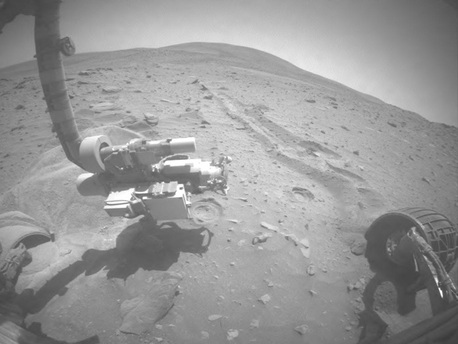Mars Rover Needs Some Sun
Mars Rover Has Uncertain Future
 © NASA/JPL-Caltech
|
Spirit attempted to turn all six wheels on Sol 2126 (Saturday, Dec. 26, 2009) to extricate itself from the sand trap known as "Troy," but stopped earlier than expected because of excessive sinkage. Telemetry indicates that the rover moved forward 3 millimeters (0.12 inch), left 2 millimeters (0.08 inch) and down (sinkage) 6 millimeters (0.24 inch). The right-front and right-rear wheels did not move.
A sand trap and balky wheels are challenges to Spirit's mobility that could prevent NASA's rover team from using a key survival strategy for the rover. The team may not be able to position the robot's solar panels to tilt toward the sun to collect power for heat to survive the severe Martian winter.
Nine months ago, Spirit's wheels broke through a crusty surface layer into loose sand hidden underneath. Efforts to escape this sand trap barely have budged the rover. The latest attempts resulted in the rover sinking deeper in the soil.
If mobility is not possible, the next priority is to improve the rover's tilt, while Spirit is able to generate enough electricity to turn its wheels. Spirit is in the southern hemisphere of Mars, where it is autumn, and the amount of daily sunshine available for the solar-powered rover is declining.
Unless the tilt can be improved or luck with winds affects the gradual buildup of dust on the solar panels, the amount of sunshine available will continue to decline until May 2010. During May, or perhaps earlier, Spirit may not have enough power to remain in operation.
The team is evaluating strategies for improving the tilt even if Spirit cannot escape the sand trap, such as trying to dig in deeper with the wheels on the north side. In February, NASA will assess Mars missions, including Spirit, for their potential science versus costs to determine how to distribute limited resources. Meanwhile, the team is planning additional research about what a stationary Spirit could accomplish as power wanes.
"Spirit could continue significant research right where it is," said Ray Arvidson of Washington University. "We can study the interior of Mars, monitor the weather and continue examining the interesting deposits uncovered by Spirit's wheels."
In 2004, Opportunity discovered the first mineralogical evidence that Mars had liquid water. The rover recently finished a two-year investigation of a half-mile wide crater called Victoria and now is headed toward Endeavor crater, which is approximately seven miles from Victoria and nearly 14 miles across. Since landing, Opportunity has driven more than 11 miles and returned more than 132,000 images.
Source: NASA
Mars Rover Needs Some Sun
Mars Rover Has Uncertain Future
 © NASA/JPL-Caltech
|
Spirit attempted to turn all six wheels on Sol 2126 (Saturday, Dec. 26, 2009) to extricate itself from the sand trap known as "Troy," but stopped earlier than expected because of excessive sinkage. Telemetry indicates that the rover moved forward 3 millimeters (0.12 inch), left 2 millimeters (0.08 inch) and down (sinkage) 6 millimeters (0.24 inch). The right-front and right-rear wheels did not move.
A sand trap and balky wheels are challenges to Spirit's mobility that could prevent NASA's rover team from using a key survival strategy for the rover. The team may not be able to position the robot's solar panels to tilt toward the sun to collect power for heat to survive the severe Martian winter.
Nine months ago, Spirit's wheels broke through a crusty surface layer into loose sand hidden underneath. Efforts to escape this sand trap barely have budged the rover. The latest attempts resulted in the rover sinking deeper in the soil.
If mobility is not possible, the next priority is to improve the rover's tilt, while Spirit is able to generate enough electricity to turn its wheels. Spirit is in the southern hemisphere of Mars, where it is autumn, and the amount of daily sunshine available for the solar-powered rover is declining.
Unless the tilt can be improved or luck with winds affects the gradual buildup of dust on the solar panels, the amount of sunshine available will continue to decline until May 2010. During May, or perhaps earlier, Spirit may not have enough power to remain in operation.
The team is evaluating strategies for improving the tilt even if Spirit cannot escape the sand trap, such as trying to dig in deeper with the wheels on the north side. In February, NASA will assess Mars missions, including Spirit, for their potential science versus costs to determine how to distribute limited resources. Meanwhile, the team is planning additional research about what a stationary Spirit could accomplish as power wanes.
"Spirit could continue significant research right where it is," said Ray Arvidson of Washington University. "We can study the interior of Mars, monitor the weather and continue examining the interesting deposits uncovered by Spirit's wheels."
In 2004, Opportunity discovered the first mineralogical evidence that Mars had liquid water. The rover recently finished a two-year investigation of a half-mile wide crater called Victoria and now is headed toward Endeavor crater, which is approximately seven miles from Victoria and nearly 14 miles across. Since landing, Opportunity has driven more than 11 miles and returned more than 132,000 images.
Source: NASA






